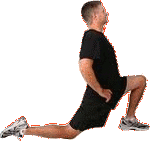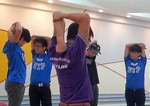Prepare To Have Fun
 All sports requiring physical effort translates into physical work. Bowling, is no different from other sports in this respect. Bowling demands sport specific physical exertion. Warming up the muscles and joints of the body is important before bowling. While bowling is a gentle exercise, it is possible for the muscles and joints to be strained over time. To minimize that possibility, it is important to warm up your muscles. While bowling may seem to be a relatively low level activity, due to the repetitive nature of the sport, when carrying and deliver a weighted ball, it is possible for the muscles and joints to be strained. Without proper preparation it is possible for minor issues (micro-trauma) to build up over time and result in injury. To help prevent this, exercises stretch and warm up the main areas that are stressed during bowling. These exercises should be done before each bowling session
All sports requiring physical effort translates into physical work. Bowling, is no different from other sports in this respect. Bowling demands sport specific physical exertion. Warming up the muscles and joints of the body is important before bowling. While bowling is a gentle exercise, it is possible for the muscles and joints to be strained over time. To minimize that possibility, it is important to warm up your muscles. While bowling may seem to be a relatively low level activity, due to the repetitive nature of the sport, when carrying and deliver a weighted ball, it is possible for the muscles and joints to be strained. Without proper preparation it is possible for minor issues (micro-trauma) to build up over time and result in injury. To help prevent this, exercises stretch and warm up the main areas that are stressed during bowling. These exercises should be done before each bowling session
During bowling, repeated strain is placed on the arms, wrists and knees. Also, many muscle groups are involved in the bowling action, including the forearms, shoulder, back, torso, hips and legs. Bowling includes many body parts moving through the range of motion involved throughout the approach and release of the ball. Warming the muscles and joints should begin with slow controlled movements, progressing through more ballistic movements, and culminate with the full bowling action.
When to warm up
The warm up should be done before each bowling session – both for practice and competition. If there are extended rest periods where you are not performing, you may have to repeat warming up to keep your muscles and joints ready to safely and consistently perform.
Getting Started
Initially you should begin the warm-up by doing some light activity to increase blood flow to the muscles. A short run, or running on the spot, or anything similar that increases your heart rate would be suitable. The next phase of the warm up is to stretch the muscles and joints.
Exercise is broadly categorized as aerobic or anaerobic. Aerobic (with oxygen) exercise is a very active type of exercise that involves improving the flow of oxygen throughout the body. Anaerobic exercise relies on stored energy sources. Anaerobic exercise uses your muscles at a high intensity for a short period of time.
Sports are either aerobic or anaerobic in nature. As an anaerobic sport, bowling does not require a continuous period of physical activity and is similar to other anaerobic sports such as golf and weightlifting.
Aerobic sports differ from activities such as swimming, tennis and running. These sports require continuous and sustained motion that cause stress on the muscles, joints and cardiovascular system.
Bowling places physical demands on an athlete’s body that are different than in other sports. Sports are further categorized as either symmetrical (shape or object has two halves that are exactly the same) or asymmetrical (shapes or objects has two halves that are not the same).
Bowling, as an asymmetrical sport, places physical demands more on one side than the other. The asymmetrical motion of bowling creates stress on several areas of the athlete’s body: Shoulder, Elbow, Hips, Wrist, Knee, Trunk, Ankle, Thigh.
To strengthen the muscle system controlling these body parts, a fitness program should be used that enhances body strength and bowling performance.
Before Bowling
Even though bowling is an anaerobic sport, there are major benefits to including aerobic training as part of your conditioning since aerobic exercise warms the body, enhances the flow of blood through the muscles, lungs and circulatory system. When engaged in aerobic exercise, the cells within the muscles demand more oxygen. The heart, lungs and circulatory system respond accordingly to deliver the needed oxygen to the working muscles. By exercising regularly, the heart, lungs and circulatory system become more efficient.
Aerobic training designed to build muscle mass, endurance and stamina, provides a worthy fitness program, and can reduce the risk of injury when bowling. For aerobic exercise to be effective, it must be practiced at least three to five times per week.
Warming Up the Body and Muscles, Tendons and Joints
Advice from USBC for Warm-Ups Prior to Bowling. and Warm-Up Routines
Stretch Coach information for Stretching Prior to Bowling.
Top End Sports Warm-Up Stretching
Pre-Game Exercise
 Bowlers also utilize anaerobic exercises to stretch and warm up prior to bowling. It is well established that muscles stiffen when not being used primarily due to the reduced flow of oxygen in the blood. Athletes starting any type of activity are well advised to limber up prior to use or risk possible injury.
Bowlers also utilize anaerobic exercises to stretch and warm up prior to bowling. It is well established that muscles stiffen when not being used primarily due to the reduced flow of oxygen in the blood. Athletes starting any type of activity are well advised to limber up prior to use or risk possible injury.
Although advising an exercise program is with pure intent, seeking appropriate guidance and permission from a qualified licensed physician as well as following common sense, remains at the cornerstone of this section.
Word To The Wise
 Staying in shape is one of the best ways to avoid trauma to your body. You are encouraged toward an aerobic and strength program to strengthen the body and reduce the risk of injury.
Staying in shape is one of the best ways to avoid trauma to your body. You are encouraged toward an aerobic and strength program to strengthen the body and reduce the risk of injury.
Injuries are often experienced because proper exercise bowling technique has not been employed or mastered. The time to think about exercise is now, and not after an injury.
Because of the necessity to seek professional guidance, only recommended areas that should be considered are included here. Employment of proper exercise technique should be obtained from qualified sources.
- Aerobic
- 3-5 times a week
- 20 minutes – 40 minutes
- Gradually increasing your Target Pulse Rate to recommended levels.
- Fast Walking
- Jogging
- Bicycle Cycling
- Swimming
- Stair Climbing
- Rowing
- Treadmill
- Anaerobic – Strength Training
- Train muscle groups gradually
- Build repetitions gradually over time
- Vary workouts focused on each muscle group
- Maintain Regular Schedule
- Resistance and frequency
- Hip and Shoulder Rotation
- Lateral Back Stretch
- Hip Rotation
- Rotator Cuff Stretch
- Train muscle groups gradually
Stretching
Hold each of the stretches for a count of 8-10 to get the maximum effect!
Shake the body or extremity to relax the muscles after each exercise.
- Neck Stretch – Tuck your chin down until it touches your chest and you can feel tension at the back of your neck.
- Shoulder Stretch – Feet apart, extend your hands downwards behind your back. Lay one hand in the other, with one thumb across the other, fingers pointing downward. Without letting your stomach stick out, pull down strongly with your hand so you can feel tension in your shoulders. Change hands and repeat.
- Side Stretch – Extend your right arm up over your head and put your right hand on your left shoulder blade (or as close as possible). Put your left hand on your right elbow and pull it across, leaning to the left as you do so, until you feel tension in your side. Change hands and repeat.
- Knee/Thigh Stretch – Place your left leg back and your right leg forward, hands on the thigh near the hip, NEVER near the kneecap! Shift your weight forward remaining as upright as possible and keeping both feet flat on the floor. Change and repeat.
- Forearm Extenders – Extend your right arm with the palm facing down. Drop the fingers and palm at the wrist. Grasp fingers with the other hand and pull towards the body. Change and repeat.
- Forearm Flexers – Extend your right arm with the palm facing away from the body and with the hand bent upwards from the wrist. Grasp your fingers with the other hand and pull towards the body. Change and repeat.
- Deep Breathing/Relaxation – take a deep breath and hold for a count of 6 (not 8 to 10 – we don’t want you to faint for lack of air!). Repeat twice (total of 3 deep breaths).
A vigorous walk will do more good for an person than all the medicine and psychology in the world.
The world wasn’t formed in a day, and neither were we. Set small goals and build upon them.
Exercise should be regarded as a tribute to the heart.
